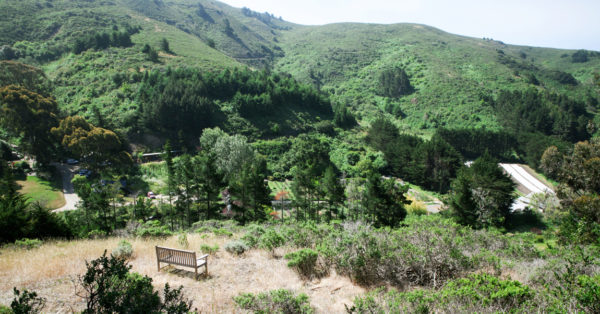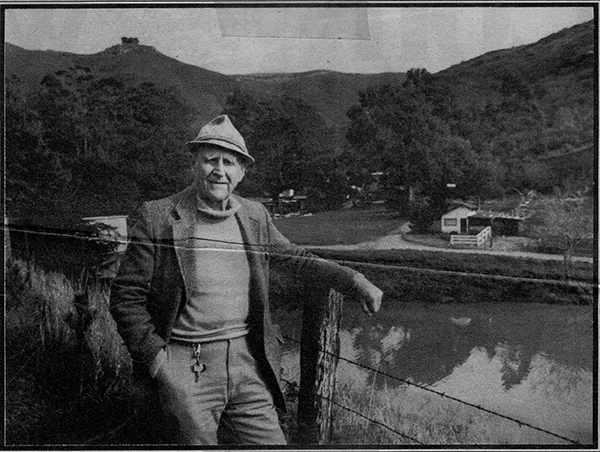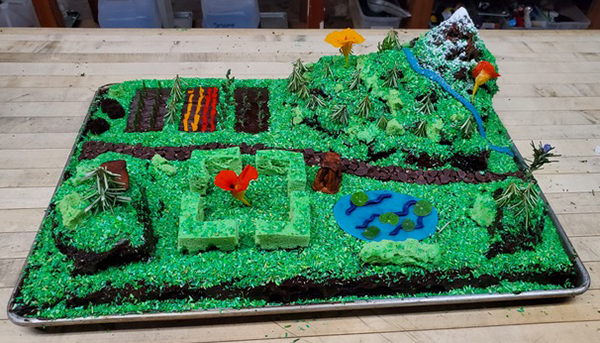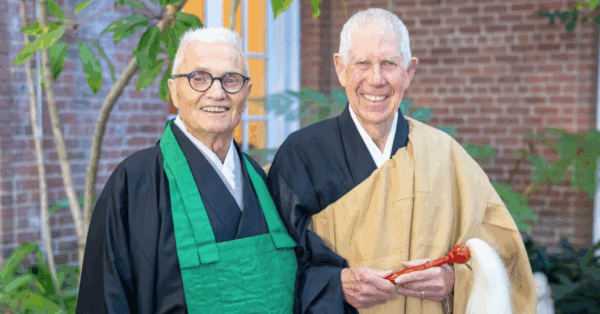
Photo by Margo Moritz
By Tova Green
Eijun Linda Cutts began her dharma talk on May 8, 2022 by holding up a solid, heavy object. It was part of the tusk of a mastodon that had been found in one of the Green Gulch fields after the land was acquired by San Francisco Zen Center in May 1972. Mastodons have been extinct for 10,000 to 11,000 years. From this perspective fifty years is a very short time.
Eijun Cutts had been practicing at City Center for a year and a half and had just graduated from U.C. Berkeley when Yvonne Rand, who was then the president of SFZC, asked her and four other “homesteaders” to move to Green Gulch in June 1972. At that time there were only a ranch house, a barn, some outbuildings, and cattle and horses on the land. They sat zazen in a room that became the library and is now the Welcome Center.

George Wheelwright at GGF
The place we now call Soryuji, Green Dragon Temple/Green Gulch Farm, was a 115-acre cattle ranch owned by George and Hope Wheelwright. George Wheelwright sold the property to San Francisco Zen Center for a very modest sum with a covenant that would have to be honored in perpetuity—to maintain a working farm and, in the spirit of the surrounding Golden Gate National Recreation Area, to keep the trail system open to the public.
In “A History of Green Gulch Farm,” published in the Windbell in 2002 on the thirtieth anniversary of Green Gulch Farm, Mick Sopko traced the ways in which Zen students, with assistance from Alan Chadwick, a gardener and horticulturist, and Harry Roberts, a Yurok trained Shaman and naturalist, created the farm and garden. Residents also refurbished the barn into a zendo and student housing (what is now Cloud Hall).

50th Anniversary cake
In the last twenty years, San Francisco Zen Center built Sky Hall and Stillwater Hall at Green Gulch to increase student housing and add retreat space. In addition, insulation and soundproofing were installed in Cloud Hall, a new welcome center and office were added, and a bread bakery was added to the kitchen. The main central buildings are now joined by wheel-chair accessible paths. There has also been extensive creek restoration that has created the conditions for coho salmon to once again thrive in the creek that runs through Green Gulch to Muir Beach.
Eijun Cutts’ talk was followed by a ceremony in the zendo. Eijun invoked the presence of coyote, bobcat, deer, great horned owl, red-winged blackbird, newt, steelhead trout, bee, lizard, “and innumerable beings seen and unseen in the soil, on the ground, in the water, in the trees and the air.” She expressed her wish:
May the time soon come when the gate will open again for all our friends to be able to be here together once more—face-to-face, protected in health.
Only through the support of beings may we practice here.
Only our practicing forever can repay the kindness [we have received].
The ceremony ended with this dedication:
On this blessed day—in the fullness of springtime, surrounded by the green hills, gardens, fields, and the sparkling ocean beyond, we mark with infinite gratitude and respect for all those who came before us to this land, the founding of Green Dragon Temple-Green Gulch Farm Zen Center, Soryuji, fifty years ago.
May we continue to learn from the earth, fire, water, and wind,
may we care for this land and this practice,
may we grow in wisdom and compassion and open our hearts,
may there be tranquility and encouragement in this valley,
may there be peace throughout the world,
and may we with all beings realize Buddha’s way.
Historical blog posts about some of the projects referred to in this article:
- It Isn’t Easy Being Red, Either: Frog Greeting Green Gulch Creek Restoration is Protected Species
- Laying a Roof and Raising Consciousness: An Interview with Contractor Ezra Wynn on Being Atop the Guest House
- It’s Green Gulch Creek, with a Twist
- Ceremony Opens a New Hall at Green Gulch As Renovation Project Nears an End
- Green Gulch Farm Projects Completed











